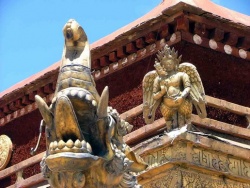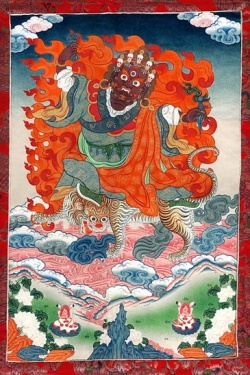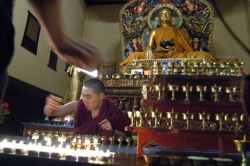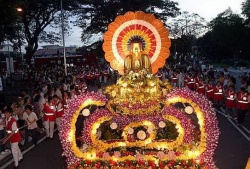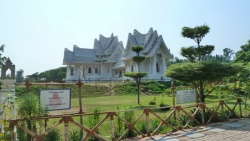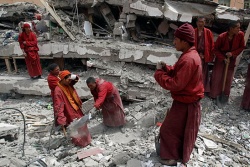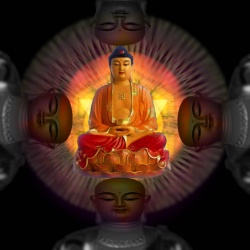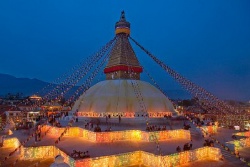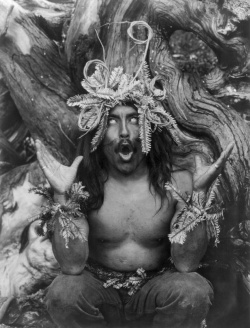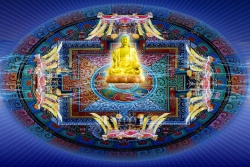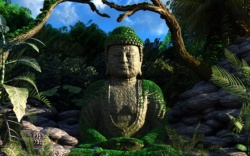The Education System of Tibetan Buddhism
Question(17): Having been engaged in Buddhist education and popular dharma propagation for a long time,
I am fairly concerned about Buddhist education. To my knowledge, Tibetan Buddhism has a very systematic and coherent scheme in its education, which has trained many of its monastic students to become outstanding and illustrious monastic talents.
Khenpo has been taking charge of the teachings in Five Sciences Buddhist Institute (Larung) for a long time, and must be very experienced in Buddhist education.
May I know something about the education system of Tibetan Buddhism?
Answer: Nowadays, it is not a simple and easy thing for an ordinary person to maintain a basic living standard, and, in addition, to attain success in society. For these, he has to strive, with great efforts,
in the turbulent torrents of the secular world, all day long, rushing, anxious, and overworked for the whole load of things that he has to face, whether for himself, his family, the livelihood, the job,
or for the children. As Buddhists, we deeply understand and sympathize with this situation.
While, for a monastic person, practising conditions, surroundings, and atmosphere are much simpler, the only thing he should be concerned about is his practice progress and the essential meaning of Buddha-dharma.
If a monk, who wears the robe of kasaya, cannot stand loneliness or resist the temptations of the outside world, ignoring all the secular people’s incessant complaints of grievance, and cries of tiredness, makes “the reckless move” to throw himself into the secular sea, and eventually, to drown himself in the mire of poisonous emotions, like the ordinary lay people do – this is a pity, indeed.
Therefore, I, from the depths of my heart, admire and respect Master Ji-qun in his efforts in dharma propagation, to benefit sentient beings.
All these actions that—as Master himself has mentioned, having been engaged in Buddhist education and popular dharma propagation for a long time – have,
on the one hand, planted the very precious seed of Buddha-dharma in the mind of the general public; and on the other, have set an exemplary figure, for the ordinary people, of what a Buddhist should be like, especially, of what a dharma-teacher or master should be like.
I have read articles written by Master, such as The Modern Significance of , and The Wisdom of Life in ; his genuine knowledge and deep insight, shining from behind the lines,
as well as his way, of both explaining the profound dharma meaning in a simplified manner and not harming the original tenets of Buddhism,
have indeed provided us with a fresh outlook, especially for the vast numbers of ordinary readers, who are not so well-trained in Buddhist learning.
Furthermore, when seeing him in person, I am even more touched by Master’s sublime and inspiring manners, pure moral discipline, and refined speech.
The most gratifying thing is, basically, that Master’s undertakings, behaviors, manners, and style, have now been replayed, and continued on, by his disciples.
Master Ji-qun’s behavior is what can be called the model for Buddhists, and what he has done is the real preserving, and supporting, of Buddhism.
Buddha-dharma propagation is not to be represented through the sheer large-scale architectural construction,
the convening of different kinds of Buddhist seminars, nor represented through the promotion of various “image Buddha-dharma”.
To turn people’s mind from worldly trifles onto Buddha-dharma wisdom, and helping them to truly understand the truths of buddhism – this is the greatest, as well as the most valuable, conduct of Buddha-dharma propagation for benefiting sentient beings.
For all dharma-teachers, the giving of empowerment, blessings, or refuge taking ceremonies, to disciples, can all be called virtuous deeds.
However, in such a society as ours – where the overall situation is that large numbers of people, who have no belief in cause-and-effect, compete among themselves,
unscrupulously, to commit all kinds of evil deeds that accumulate bad karma – to offer sentient beings with a formal, pure,
orthodox Buddhist education, appears to be especially crucial.
And as a monk of Tibetan Buddhism, with nearly twenty-years of learning experience in the Five Sciences Buddhist Institute (Larung), I do think this, from my own experience, to be true.
I am far from being experienced in Buddhist teaching, but I do have some heart-felt tips gained from my experience.
From the day I stepped into the palace of Buddha-dharma, I have deeply revered the speeches and actions of the great spiritual masters and virtuous people, in the past or at present,
who were not attached to the mundane deeds of worldly concerns, and who taught the dharma and the sacred path with a completely selfless and altruistic mind; and at the same time,
I am also deeply proud of the unique, rigorous, scientific Buddhist education system in the Tibetan region.
Thanks to there being such a system in Buddha-dharma education, a large number of mahāsiddhas (great spiritual masters who have attained the supreme accomplishment) are outstanding; and again, thanks to their efforts, generations of Buddhist practitioners can continue to grow up,
sturdily, in this continuous monastic-talents-cultivating system, where lineage transmissions remain unbroken and intact.
The beginning of Tibetan Buddhist education can be traced back to around the middle of the 8th century.
When King Trisong Detsen invited Guru Rinpoche Padmasambhava to come to Tibet, and established the Samyé Monastery in a place now named Shannan (Lhoka Prefecture, or the South of Mountains), young Tibetans were initiated to become monks, successively.
From then on, monastery-based communities for Buddhist education and practice took shape. During the Earlier Propagation Period, not only had monastic education witnessed its development, but also departmental teaching appeared and grew to a certain scale. When it came to the Later Propagation period,
the monasteries’ position as the basis of education turned out to be more significant than ever, and furthermore, specialized colleges, of various subjects named after the great treatises, such as the Commentary on Dignaga’s ‘Compendium of Valid Cognition’ (Pramāṇavārttikakārika),
The Ornament of Clear Realization (Abhisamaya-alaṅkāra), and Introduction to the Middle Way (Madhyamakāvatāra), also sprang up, more vigorously than ever.
Sakya Pandita Kunga Gyaltsen has also written a book titled The Entrance Gate for the Wise, elucidating theories on the three aspects: dharma teaching, philosophical debate, and the composition of texts,
in which he also touched upon the education concept and plausible measures in Tibetan Buddhism, thus providing, to some extent, a theoretical foundation for the further standardization of monastic education.
In Year 1409, Master Je Tsongkhapa founded Ganden Monastery in Tagtse County of Lhasa, and from then on, the Gelug school that he established was fully developed, and it spread throughout Tibet.
And for a period, Gelugpa monasteries flowered throughout the entire Tibetan region, like new bamboos shooting up after a spring rain, and before long,
the three great university monasteries in Lhasa (“the Great Three” of Gelugpa university monasteries) – Ganden, Sera, and Drepung – implemented a rigorous monastic education system, in all the other Gelugpa monasteries in the Tibetan region.
The monastic education system in the Gelugpa order has a tremendous influence in all of Tibetan Buddhism, and its reaching span is also very wide. Let me use the Gelugpa monastic education system as an example, and give you a specific analysis of the education characteristics of Tibetan Buddhism.
When monastic students enter monasteries and start their formal scripture studies, generally there are three types (of study sequence):
in the first type, students study the exoteric Buddhism first and then the esoteric Buddhism, which means they will begin their study in the Sutrayana college,
and graduate from there, after obtaining the Geshe degree, and then go to a Tantrayana college for tantric study, but by the time they graduate, they still remain as Sutrayana scholars; in the second type,
they go to study in a Tantrayana college directly, or enter the Medical college, or the Kālachakra college;
in the third type, they will study only in the Sutrayana college, and will not go further to a tantric college.
The curriculum in the Sutrayana college is fixed, and it focuses on the study of what people usually call – “The Five Major Texts”: Treatise on Valid Cognition (Pramāṇavarttika) by great commentator Dharmakīrti,
Ornament of Clear Realization (Abhisamayālaṃkāra) by Bodhisattva Maitreya, Introduction to the Middle Way (Madhyamakāvatāra) by Bodhisattva Candrakīrti,
The Root of the Vinaya (Vinaya-mūla-sūtra) by the Pandita Gunaprabha, Treasury of Higher Knowledge (Abhidharma Kośa) by Bodhisattva Vasubandhu.
Usually, it takes over fifteen years to finish the study of these five great texts, and normally, you need to finish one subject before you can go to another, and textual recitation and memorization, as well as a coherent and thorough understanding, are particularly valued.
A monastic, who has more than fifteen years of study in the Sutrayana college, gets the chance to be a candidate for the Geshe degree.
Tantrayana college is where the Gelugpa monastics learn tantric studies.
Ganden Monastery has two tantric colleges: Gyütö (The Higher Tantric College) and Gyümé (The Lower Tantric College).
These two tantric colleges are the highest institutes in the Gelugpa lineage, and the candidates for the “lion” dharma seat of Je Tsongkhapa— Ganden Tripa, come from monks of these two tantric colleges.
Ganden Tripa, or the holder of the “lion” dharma throne of Je Tsongkhapa, is the spiritual head and the highest academic position in the Gelugpa lineage.
This position is awarded entirely on the basis of hierarchical progression in the candidate’s level of dharma-listening, reflection, and meditation, proven in the tests, and the route to the position, itself, fully reveals the rigorousness and the staged order of the education system of Tibetan Buddhism.
In order to become a Ganden Tripa, a student needs, firstly, to acquire the 1st Ranked Geshe Lharampa title, the highest Geshe degree in Sutrayana colleges, and then, to enter the Higher (Gyütö) or
the Lower (Gyümé) Tantric College of Ganden to have an advanced study, which will take more than five years; upon completion of all the tantric curriculum,
and having passed the ritualized tantric examination, he should assume the position of Gego and serve four months, and then, serve three years as an Umtze,
three years as a Khenpo, and several years as a Khensur; after that, he must become either the Sharpa Chöjé, the abbot of Gyütö, (the Higher Tantric College), or Jangtsé Chöjé, the abbot of Gyümé, (the Lower Tantric College), with a tenure of fourteen years;
if the throne of Ganden Tripa is vacant by then, he has the chance to become a candidate for the throne.
So, the difficulty for a monastic student to become the precious-throne holder of Ganden Tripa, is almost as great as that of climbing onto the blue sky.
That’s why among the Tibetan people, there is an idiom that goes like this: “If a mother’s son has the right qualifications, the Ganden throne is open to him.”
As for the ordinary tantric colleges, usually they consist of three academic grades: the junior, the middle, and the senior, and each of the three has a fixed curriculum and different requirements, respectively.
Having finished all the prescribed curriculum of the tantric college, and having passed the examinations, students can be conferred the corresponding academic degree that the monastery will offer, which may vary, depending on the monastery, in the different regions.
Generally speaking, the medical science college and the kālachakra college are affiliated to major monasteries, and consist, too, of three academic grades: the junior, the middle, and the senior.
Upon completion of the specialized curriculum of all the three grades, students can take the exams and be conferred a M.D., or, a Doctorate in Astrology and Calendric Researches, respectively.
The aforementioned is a brief shot of the Buddhist education system of the Gelugpa school, and now, let me also take Five Sciences Buddhist Institute (Larung), the one I am in, as another example, and give you a little introduction to the education style of the Nyingmapa lineage.
In general, its teaching patterns is very similar to that of the Gelugpa lineage, however, the minor difference between the two, that sparkles amidst their general resemblance, may help you perceive the variety and colorfulness in the characteristics of Tibetan Buddhist education.
A combining of the two would, presumably, foster in your mind a clear and intact picture of the educational features of Tibetan Buddhism.
No matter what Buddhist lineage you were in, previously, and no matter which dharma tradition you have set your mind on propagating, in the future, the Five Sciences Buddhist Institute (Larung) welcomes you all.
The Institute would observe each person who enters Larung, carefully, in aspects such as the personality of the student, his or her qualifications in Buddhist understanding, etc.,
then if the student is considered to be qualified, he or she will be allowed to stay in the Institute for further studies. Once accepted, practitioners are required, generally, to spend about one year on finishing the preliminary practices, as well as some foundational Buddhist courses.
After that, they will begin their study in different Sutrayana subjects, in a staged order, for instance:
Vowed Morality(Vinaya), first, and then, onto Middle Way (Madhyamaka), Logic (Hetuvidya), Abhidharma (Treasury of Higher Knowledge, Abhidharma Kośa), and, Ornament of Clear Realization (Abhisamayālaṃkāra), etc..
Usually, each subject will take about one year’s study. Only on completion of the five years’ study of Sutrayana curriculum can practitioners move on to Tantrayana studies.
The tantric teachings are divided into two classes: one is the class of tantric theories, and the other is the class of genuine practice – it takes about two years to complete these courses.
The remainder of time is spent on the study of medical science and other subjects. When students complete all the courses in the Institute, about twelve years will have flown by, swiftly but meaningfully.
For some practitioners, it takes only six years for them to finish all the Sutrayana and Tantrayana studies, which cost others twelve years; if this is the case, they can graduate ahead of time.
As long as you study seriously in accordance with the Institute’s teaching requirements, through these years’ study, you can basically master all the five major sciences of Buddhism, which are:
Inner Science (adhyatma), Logic( hetu), Medicine (cikitsa), Fine Arts (silpa), Grammar (sabdavidya), as well as the five minor sciences, which are: Prosody (chanda), Poetics (kāvya), Synonymy (abhidhāna), Drama (nāṭaka), and Astrology (jyotiṣa).
In the whole life of a human being, twelve years actually is short and swift, however, for a person who truly wants to learn the great dharma that leads to emancipation from birth and death, in Larung, these fast-flying twelve years will bring him inexhaustible accumulations of merit and wisdom for all his future lives.
If we could also recall the fact that, in the ocean of profit, secular people are accumulating the karma of samsara in every minute, every second of these twelve years, a mixed feeling of sadness and joy might arise in our heart, spontaneously:
sad about the ordinary people’s ignorance, and joyful about the choice by “the son of the Buddha”.
Actually, how many days and hours of our life have been spent on studying, and on doing things that cause samsara?
On hearing that the length of schooling in Larung is twelve years, and that it would be fifteen years, twenty years, or even more, in that of the Gelugpa lineage, many people might be astounded, thinking that spending so many days and hours in studying Buddha-dharma is, indeed, a bit too long.
Yet, if it is compared with the long, endless nights of cyclic existence, ordinary people will be able to tell which one of the two is longer, won’t they?
Within the education system of of Tibetan Buddhism in its entirety, no matter whether it is in the Gelugpa monasteries, or in the Buddhist institutes of other lineages, selecting Khenpo, Geshe, or various other monastic talents on basis of dharma teaching, philosophical debate, and the composition of texts, after long years of dharma listening, reflecting, and meditating, is a way that is fairly commonly adopted.
In each lineage, the academic degrees of Khenpo are generally divided into three corresponding levels: the higher, the middle, and the lower, in a way just like that of “the Great Three” Lhasa monasteries of the Gelugpa tradition, dividing Geshe into different levels, such as Lharampa, Lingtse, Dorampa, etc..
If we want to match them with the secular academic degrees, the 1st Ranked Geshe Lharampa is similar to Ph.D, Geshe Lingtse is similar to the Master’s degree, and Geshe Dorampa is similar to the Bachelor’s degree.
Secular people usually regard obtaining different kinds of academic degrees as a target, or a driving force of their life’s objectives, since academic degrees are often closely linked with their personal benefits.
There are also various kinds of academic degrees in Tibetan Buddhism, but they only stand for an acknowledgment and a confirming of the conferee’s qualifications in Buddhist studies, and have nothing to do with the so-called “interests” of the conferee.
If there could be anything to do with the interests, undoubtedly these interests or benefits are connected with their non-worldly, ultimate target.
What has been mentioned above is only a brief introduction to the education system of Tibetan Buddhism, and those who are interested to know further may go deep into the Tibetan region by themselves and make a thorough exploration. Once you step through the gate of Tibetan Buddhism, the infinite, splendid, views would, perhaps, come to you, immediately, and continuously.
And by that time, perhaps you would feel like devoting the whole of your limited life into this unlimited, great, classroom of Tibetan Buddhism.
Source
http://www.khenposodargye.org/2015/05/the-education-system-of-tibetan-buddhism/
